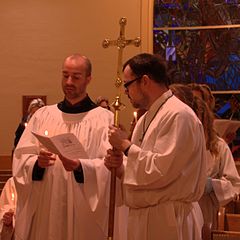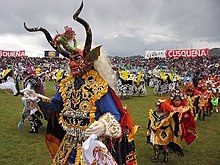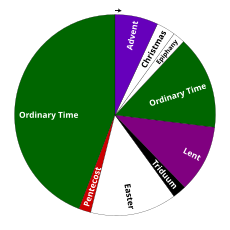Candlemas
| Candlemas Candlemass Candlemas Day | |
|---|---|
 Blessing of candles on Candlemas at an Episcopal Church in the United States | |
| Also called | Feast of the Presentation of Our Lord Jesus Feast of the Purification of the Blessed Virgin Mary |
| Observed by | Christians |
| Significance | Commemoration of the presentation of Jesus at the Temple |
| Observances | Having candles blessed for the year during a Mass or Service of Worship; removal of Christmas decorations in some localities |
| Date | February 2 |
| Frequency | Annual |
| Related to | Christmastide, Epiphanytide |
Candlemas (also spelled Candlemass), also known as the Feast of the Presentation of Our Lord Jesus and the Feast of the Purification of the Blessed Virgin Mary, is a Christian Holy Day commemorating the presentation of Jesus at the Temple. It is based upon the account of the presentation of Jesus in Luke 2:22–40. In accordance with Leviticus 12: a woman was to be presented for purification by sacrifice 33 days after a boy's circumcision. It falls on February 2, which is traditionally the 40th day of the Christmas–Epiphany season.[1] While it is customary for Christians in some countries to remove their Christmas decorations on Twelfth Night (Epiphany Eve),[2] those in other Christian countries historically remove them on Candlemas.[3][4] On Candlemas, many Christians (especially Anglicans, Methodists, Lutherans, Orthodox and Roman Catholics) also bring their candles to their local church, where they are blessed and then used for the rest of the year;[5][6] for Christians, these blessed candles serve as a symbol of Jesus Christ, who referred to himself as the Light of the World.[7]
Contents
1 History
2 Celebrations
2.1 France, Belgium, and Swiss Romandy
2.2 Luxembourg
2.3 United States and Canada
2.4 Tenerife and Philippines
2.5 Guatemala
2.6 Mexico
2.7 Peru
3 See also
4 References
5 Bibliography
History

A tapestry from Strasbourg depicting the Purification of the Virgin Mary and the Presentation of Jesus at the Temple

The Feast of the Presentation of Jesus at the Temple being celebrated through Mass at the Helsinki Lutheran Cathedral (2015).
The Feast of the Presentation is one of the oldest feasts of the Christian church, celebrated since the 4th century AD in Jerusalem. There are sermons on the Feast by the bishops Methodius of Patara (died 312), Cyril of Jerusalem (died 360), Gregory the Theologian (died 389), Amphilochius of Iconium (died 394), Gregory of Nyssa (died 400), and John Chrysostom (died 407). It is also mentioned in the pilgrimage of Egeria (381–384), where she confirmed that the celebrations took place in honor of the presentation of Jesus at the Temple.
XXVI. [The Purification of the Blessed Virgin Mary.] But certainly the Feast of the Purification is celebrated here with the greatest honour. On this day there is a procession to the Anastasis; all go in procession, and all things are done in order with great joy, just as at Easter. All the priests preach, and also the bishop, always treating of that passage of the Gospel106 where, on the fortieth day, Joseph and Mary brought the Lord into the Temple, and Simeon and Anna the prophetess, the daughter of Famuhel, saw Him, and of the words which they said when they saw the Lord, and of the offerings which the parents presented. And when all things have been celebrated in order as is customary, the sacrament is administered, and so the people are dismissed.[8]
Christmas was, in the West, celebrated on December 25 from at least the year AD 354 when it was fixed by Pope Liberius. Forty days after December 25 is February 2. In the Eastern parts of the Roman Empire, Roman consul Justin established the celebration of the Hypapante on February 2, AD 521.
Pope Gelasius I (492–496) contributed to the spread of the celebration, but clearly did not invent it. Moreover, the link made by Caesar Baronius between the presentation of Jesus and Lupercalia is probably inaccurate since Lupercalia was not celebrated in Jerusalem and it was only there that one finds some celebrations of the presentation of Jesus around this date. But it appears that it became important around the time of the Plague of Justinian in 541, before slowly spreading West. The ancient Romans celebrated the Lupercalia in mid-February, in honor of Lupercus, the god of fertility and shepherds. The celebration of Feralia occurred at the same time.
The Lupercalia have frequently been linked to the presentation of Jesus at the temple, particularly by Cardinal Caesar Baronius in the 16th century[9][10] especially because of the theme of purification that the two festivals share. In fact, Pope Gelasius I had much earlier written a letter to a senator Andromachus, who wanted to reestablish the Lupercalia for the purpose of purification; and the so-called Gelasian Sacramentary mentions the celebration of the Presentation of Jesus, lending support to the conclusion that Gelasius substituted a Christian festival for a pagan one. However the Gelasian Sacramentary shows a strong Gallican influence and was actually compiled between AD 628 and AD 731, so it is possible that the addition of the celebration was not due to Pope Gelasius at all.
Moreover, when Gelasius addressed Andromachus, he did not try to use his authority, but contented himself to arguing for example that the Lupercalia would no longer have the effect it once had and was incompatible with Christian ideals.[9] This could be interpreted as evidence that he had limited influence on the Roman aristocracy.[11]
Centuries later, around the year 1392 or 1400, an image of the Virgin Mary that represented this invocation, was found on the seashore by two Guanche shepherds from the island of Tenerife (Canary Islands).[12] After the appearance of the Virgin and its iconographic identification with this biblical event, the festival began to be celebrated with a Marian character in the year 1497, when the conqueror Alonso Fernández de Lugo celebrated the first Candlemas festival dedicated especially to the Virgin Mary, coinciding with the Feast of Purification on February 2.[13][14] Before the conquest of Tenerife, the Guanche aborigines celebrated a festivity around the image of the Virgin during the Beñesmen festival in the month of August. This was the harvest party, which marked the beginning of the year. Currently, the feast of the Virgin of Candelaria in the Canary Islands is celebrated in addition to February 2 also on August 15, the day of the Assumption of the Virgin Mary in the Catholic calendar. For some historians, the celebrations celebrated in honor of the Virgin during the month of August are a syncretized reminiscence of the ancient feasts of the Beñesmen.[15]
Candlemas feast transfers to February 3 if February 2 is a pre-Lenten Sunday, but the blessing of candles still takes place on February 2. Candlemas never falls in Lent (this also applies to the ordinary-form calendar), because the earliest possible Ash Wednesday is February 4.
In Swedish and Finnish Lutheran Churches, Candlemas is (since 1774) always celebrated on a Sunday, at the earliest on 2 February and at the latest on 8 February, except if this Sunday happens to be the last Sunday before Lent, i.e. Shrove Sunday or Quinquagesima (Swedish: Fastlagssöndagen, Finnish: Laskiaissunnuntai), in which case Candlemas is celebrated one week earlier.[16]
Celebrations
France, Belgium, and Swiss Romandy

Crêpes are a traditional food on Chandeleur, or Candlemas.
Candlemas is celebrated in the churches on February 2. It is also considered the day of crêpes. Tradition attributes this custom to Pope Gelasius I, who had pancakes distributed to pilgrims arriving in Rome, but as mentioned earlier one can also see it as a vestige of the custom of Vestal Virgins making offerings of cakes at the time of the Lupercalia.
To celebrate Candlemas, all the candles in the house should be lit. Tradition also says manger scenes should not be put away until Candlemas, which is the last feast of the Christmas cycle.
It is also said that the pancakes, with their round shape and golden color reminiscent of the solar disc, refer to the return of Spring after the dark and cold of Winter.
Even today there is a certain symbolism associated with the preparation of the crêpes. A tradition dating back to the late fifth century[citation needed] and linked to a fertility rite is to flip the crepes in the air with the right hand while holding a gold coin (such as a Louis d'or) or some other coin in the left hand, in order to have prosperity throughout the year. One has to ensure that the pancake lands properly back in the pan. It is also said that the first crepe made should be kept in an armoire to ensure a plentiful harvest later in the year. It is sometimes specified that it be placed at the top of the armoire, and the pancake will supposedly not get moldy and will keep misery and deprivation far away.[citation needed]
Luxembourg
Being a descendant of an ancient torchlight procession, the current tradition of Liichtmëssdag is a holiday centered around children. In small groups, they roam the streets in the afternoon or evening of February 2, holding a lighted lantern or homemade wand, singing traditional songs at each house or store, especially "Léiwer Härgottsblieschen". In exchange for the music, they hope to receive a reward in the form of sweets or loose change (formerly bacon, peas, or biscuits).[citation needed]
United States and Canada
This festivity officially finalizes the end of Christmas for Christians in Puerto Rico; the festivities include a procession where the statue of the "Virgen de la Candelaria" is carried on the shoulders. Others follow with lit candles until they reach a church where a Mass is celebrated. In the evening the festivities continue with a giant bonfire and singing.
Tenerife and Philippines

Virgin of Candelaria (patron of the Canary Islands). In this Spanish archipelago began the identification of the Candlemas with the Virgin Mary.
The Virgin of Candelaria or Our Lady of Candelaria (Spanish: Virgen de Candelaria or Nuestra Señora de la Candelaria), popularly called La Morenita, celebrates the Virgin Mary on the island of Tenerife, one of the Canary Islands (Spain). The center of worship is located in the city of Candelaria in Tenerife. She is depicted as a Black Madonna. The "Royal Basilica Marian Shrine of Our Lady of Candelaria" (Basilica of Candelaria) is considered the main church dedicated to the Virgin Mary in the Canary Islands.[17] Her feast is celebrated on February 2 (Fiesta de la Candelaria) and August 15, the patronal feast of the Canary Islands.
In the Philippines, she is also the patroness of Western Visayas region enshrined in Jaro Cathedral or the National Shrine of Our Lady of Candles under the Archdiocese of Jaro (with feast day every 2 February), and Barangay Tatala in Binangonan, Rizal, which celebrates her feast on the First Saturday of February. In Silang, Cavite, her feast is observed locally as a triduum from February 1 to 3, with February 2 kept as the actual feast day.
Guatemala
The Virgin of Candelaria is the patron saint of Jacaltenango and her feast is celebrated on February 2, marking the end of the Christmas season.[17]
Mexico
In Mexico, it is traditional to celebrate the presentation of the Christ child in the temple on February 2. The dressing and adoration of the child Jesus and family meals with tamales are an important Mexican tradition.[18]
This festival is closely linked to that of the Epiphany, during which the tasting of the rosca de reyes (kings cake) will determine who is responsible for organizing Candlemas. Whoever finds the muñeco (bean-shaped Christ child) in the cake is named godfather of the child, who will then dress the niño dios (an image of the Christ child in the form of a doll) on Candlemas with richly decorated clothes, which is then brought to the church to be blessed. Memories of these events are often passed down from generation to generation in families.[citation needed]
Following this is the family meal. Whoever draws the bean on Epiphany must also prepare tamales, which is believed to echo Mexico's pre-Christian past with its offerings of maize. The whole family is invited to this meal (often the same people as for the Rosca at Epiphany), which gives the festival an aspect of family and sharing. These celebrations take place not only in Mexico but also in Mexican communities around the world, for instance in France. It is for this reason that the Mexican tradition also appears in the Inventaire du patrimoine culturel immatériel en France.
Peru

Diablada puneña during the Fiesta de la Candelaria in Peru.
The Virgin of Candelaria is the patron saint of the city of Puno in Peru, held in the first fortnight of February each year. It is one of the largest festivals of culture, music and dancing in Peru. In terms of the number of events related to the cultures of the Quechua and Aymara peoples and of the mestizos of the Altiplano, and also in terms of the number of people directly and indirectly involved in its realization, it stands with the Carnival in Rio de Janeiro and the Carnaval de Oruro in Bolivia as one of the three largest festivals in South America.
At the core of the festival are performances of music and dance organized by the Regional Federation of Folklore and Culture of Puno, consisting of more than 200 dances in more than 150 dance sets. These include "native dances" from the various communities in Puno and sets of dances organized in different quarters of the city, mostly those known as "costume dances". These performances directly involve 40,000 dancers and some 5,000 musicians, and indirectly involve about 25,000 people including directors, sponsors, embroiderers and the makers of masks, clothing, boots, shoes, bells and other items.
See also
- Liturgical year
Imbolc, a Celtic festival celebrated near the same time- Presentation of Jesus at the Temple
References
^ Knecht, Friedrich Justus (1910). A Practical Commentary on Holy Scripture. B. Herder. p. 410. Retrieved 27 December 2016.We keep a feast on the 2nd of February, forty days after Christmas, in memory of our Lord's Presentation in the Temple. This feast has several names. First, it is known as the Feast of the Presentation of our Lord Jesus. Secondly, it is called the Feast of the Purification of the Blessed Virgin Mary. But the usual and popular name for this Feast is Candlemas-day, because on this day candles are blessed before Mass, and there takes place a procession with lighted candles. Candles are blessed and lighted on this particular feast.
.mw-parser-output cite.citationfont-style:inherit.mw-parser-output .citation qquotes:"""""""'""'".mw-parser-output .citation .cs1-lock-free abackground:url("//upload.wikimedia.org/wikipedia/commons/thumb/6/65/Lock-green.svg/9px-Lock-green.svg.png")no-repeat;background-position:right .1em center.mw-parser-output .citation .cs1-lock-limited a,.mw-parser-output .citation .cs1-lock-registration abackground:url("//upload.wikimedia.org/wikipedia/commons/thumb/d/d6/Lock-gray-alt-2.svg/9px-Lock-gray-alt-2.svg.png")no-repeat;background-position:right .1em center.mw-parser-output .citation .cs1-lock-subscription abackground:url("//upload.wikimedia.org/wikipedia/commons/thumb/a/aa/Lock-red-alt-2.svg/9px-Lock-red-alt-2.svg.png")no-repeat;background-position:right .1em center.mw-parser-output .cs1-subscription,.mw-parser-output .cs1-registrationcolor:#555.mw-parser-output .cs1-subscription span,.mw-parser-output .cs1-registration spanborder-bottom:1px dotted;cursor:help.mw-parser-output .cs1-ws-icon abackground:url("//upload.wikimedia.org/wikipedia/commons/thumb/4/4c/Wikisource-logo.svg/12px-Wikisource-logo.svg.png")no-repeat;background-position:right .1em center.mw-parser-output code.cs1-codecolor:inherit;background:inherit;border:inherit;padding:inherit.mw-parser-output .cs1-hidden-errordisplay:none;font-size:100%.mw-parser-output .cs1-visible-errorfont-size:100%.mw-parser-output .cs1-maintdisplay:none;color:#33aa33;margin-left:0.3em.mw-parser-output .cs1-subscription,.mw-parser-output .cs1-registration,.mw-parser-output .cs1-formatfont-size:95%.mw-parser-output .cs1-kern-left,.mw-parser-output .cs1-kern-wl-leftpadding-left:0.2em.mw-parser-output .cs1-kern-right,.mw-parser-output .cs1-kern-wl-rightpadding-right:0.2em
^ A Study Guide for William Shakespeare's "Twelfth Night" (2 ed.). Cengage Learning. p. 29. ISBN 9781410361349.Twelfth Night saw people feasting and taking down Christmas decorations. The king cake is traditionally served in France and England on the Twelfth Night to commemorate the journey of the Magi to visit the Christ child.
^ Edworthy, Niall (7 October 2008). The Curious World of Christmas. Penguin Group. p. 83. ISBN 9780399534577.The time-honoured epoch for taking down Christmas decorations from Church and house in Candlemas Day, February 2nd. Terribly withered they are by that time. Candlemas in old times represented the end of the Christmas holidays, which, when "fine old leisure" reigned, were far longer than they are now.
^ Roud, Steve (31 January 2008). The English Year. Penguin Books Limited. p. 690. ISBN 9780141919270.As indicated in Herrick's poem, quoted above, in the mid seventeenth century Christmas decorations were expected to stay in place until Candlemas (2 February), and this remained the norm until the nineteenth century.
^ Hothersall, Barbara. "Candlemas – Festival of Light". Fulwood Methodist Church Magazine. Retrieved 27 December 2016.In some countries special candles are brought along to the blessing by the worshippers. These are often very elaborate and are highly treasured. Afterwards they are taken home and kept to be lighted at times of stress – during storms, in sickrooms and at the bedside of the dying.
^ Pappas, Christopher A. (18 January 2012). "Ecumenical Candlemas (Feast of the Presentation)". Holy Trinity Anglican Church. Retrieved 27 December 2016.Please join us for a Choral Evensong for Candlemas with the combined choirs of Holy Trinity Anglican Church and Trinity Lutheran Church, followed by a reception hosted by the two choirs. ... Candlemas has been the traditional time when the candles of the church are blessed for the upcoming year. According to some sources, Christians began Candlemas in Jerusalem as early as the fourth century and the lighting of candles began in the fifth century.
^ Mazar, Peter (6 March 2015). To Crown the Year: Decorating the Church through the Seasons (2 ed.). Liturgy Training Publications. p. 253. ISBN 9781618331328.
^ "The Pilgrimage of S. Silvia of Aquitania to the Holy Places". digital.library.upenn.edu.
^ ab William M. Green, "Lupercalia in the fifth century", Classical Philology, no Vol. 26 n°1, janvier 1931, p. 60–69 (lire en ligne)
^ (la) Barri Ducis, L.Guerin, Annales Ecclesiastici Caesaris Baroni, 186, t.
^ George E. Demacopoulos, The Invention of Peter: Apostolic Discourse and Papal Authority in Late Antiquity, University of Pennsylvania Press, 2013, 74–80 p.
^ "Candelaria, Nuestra Señora". corazones.org. Retrieved 2019-02-19.
^ Tenerife, La Opinión de. "Medio siglo de fervor en Candelaria". www.laopinion.es (in Spanish). Retrieved 2019-02-19.
^ "Turismo Tenerife: Alojamiento, Carnaval, Actividades... | Tenerife". www.webtenerife.com. Retrieved 2019-02-19.
^ Álvarez Delgado, Juan (1949). Sistema de Numeración Norteafricano. A. Numerales Canarios.- B. Sistema Numeral Norteafricano: Caracteres. Estudio de lingüística comparada sobre el sistema de numeración y cómputo de los aborígenes de Canarias. Madrid: Instituto Antonio de Nebrija (CSIC).
^ Oja, Heikki (2007). Aikakirja 2007 (in Finnish). Helsinki: Almanach office of Helsinki University. p. 147. ISBN 952-10-3221-9.
^ ab Bayor, Ronald H. (31 July 2011). "Multicultural America: An Encyclopedia of the Newest Americans". ABC-CLIO – via Google Books.
^ "What Is The True Meaning Of Día De La Candelaria?". latintimes.com. 19 January 2016.
Bibliography
Mythologie chrétienne, Ph.Walter, éd: Imago.
La Mémoire du temps. Fêtes et calendriers de Chrétien de Troyes à la Mort Artu., Ph.Walter. Paris : Champion, 1989.
Proverbes et dictons de toujours. Marie-Odile Mergnac et Thomas Köhler. Paris, Archives et cultures 2008.

